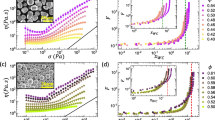Abstract
Various techniques have been proposed to characterize the behavior in the non-linear regime. A new theoretical framework, as proposed recently by Ewoldt et al. (J Rheol 52(6):1427–1458, 2008), provides a quantitative analysis of Lissajous figures during large-amplitude oscillatory shear (LAOS). Intra- and intercycle non-linearities, strain stiffening and softening, and shear thinning and thickening are described and can be distinguished. The new LAOS framework from Ewoldt et al. has been extended to a sinusoidal stress input. Measurements on two different samples reveal significant different results for sinusoidal strain or sinusoidal stress input. For both sinusoidal inputs, the results have been verified by cyclic stress and strain loading tests. The sinusoidal input tests are analyzed as an oscillatory test by the rheometer software and firmware, whereas the cyclic loading tests are purely rotational tests. Since both types of testing give the same results, any instrumental artifacts can be excluded. This implies that complex fluids can behave differently whether periodic stress or strain input functions outside the linear visco-elastic range are applied. All tests in controlled strain and stress in rotational and oscillatory modes have been performed with the same rheometer based on an air bearing-supported electrically commutated synchronous motor.
















Similar content being viewed by others
References
Atalik K, Keunings R (2004) On the occurrence of even harmonics in the shear response of viscoelastic fluids in large amplitude oscillatory shear. J Non-Newtonian Fluid Mech 122:107–116
Barnes HA, Bell D (2003) Controlled-Stress rotational rheometry: an historical review. Korea-Australia Rheol J 15:187–196
Baravian C, Quemada D (1998) Using instrumental inertia in controlled stress rheometry. Rheol Acta 37:223–233
Baravian C, Benbelkacem G, Canton F (2007) Unsteady rheometry: can we can characterize weak gels with a controlled stress rheometer. Rheol Acta 46:577–5812
Cho KS, Hyon K, Ahn KH, Lee SJ (2005) A geometrical interpretation of large amplitude oscillatory shear response. J Rheol 49:747–758
Certificate for SRM2490 (2010) https://www-s.nist.gov/srmors/view_cert.cfm?srm=2490
Davis S (1969) A modification to a variable shear stress air turbine viscometer. J Phys E 2:102–103
Davis S, Deer JJ, Warburton B (1968) A concentric cylinder air turbine viscometer. J Phys E 1:933–936
Dealy JM, Wissbrun KF (1990) Melt rheology and its role in plastics processing: theory and applications. Van Nostrand, New York
Debbaut B, Buhrin H (2002) Large amplitude oscillatory shear and Fourier-transform rheology for a high density polyethylene: experiments and numerical simulations. J Comput Chem 46:1155–1176
Ewoldt RH (2009) Nonlinear viscoelastic materials: bioinspired applications and new characterization measures. PhD thesis, Mechanical Engineering, Massachusetts Institute of Technology
Ewoldt RH, McKinley GH (2007) Creep ringing in rheometry or how to deal with oft-discarded data in step stress tests. Rheol Bull 76(1):4–6, 22–24
Ewoldt RH, Hosoi AE, McKinley GH (2008) New measures for characterizing nonlinear viscoelasticity in large amplitude oscillatory shear. J Rheol 52(6):1427–1458
Franck AJP (1985) A rheometer for characterizing polymer melts and suspensions in shear creep and recovery experiments. J Rheol 29:833–850
Gevgilili H, Kaylon DM (2001) Step strain flow: wall slip effects and other sources of error. J Rheol 45:467–475
Giacomin AJ, Dealy JM (1998) Large-amplitude oscillatory shear. In: Collyer AA, Clegg DW (eds) Rheological measurements, 2nd edn. Chapman & Hall, London
Graham MD (1995) Wall slip and the nonlinear dynamics of large-amplitude oscillatory shear flows. J Rheol 39:697–712
Heyman L, Peukert S, Aksel N (2002) Investigations of the solid-liquid transition of highly concentrated suspensions in oscillatory amplitude sweeps. J Rheol 46:93–112
Hyun K, Nam JG, Wilhelm M, Ahn KH, Lee SJ (2003) Nonlinear response of complex fluids under LAOS (large amplitude oscillatory shear) flow. Korea-Australia Rheol J 15:97–105
Kim SH, Sim HG, Ahn KH, Lee SJ (2002) Large amplitude oscillatory shear of the network model for associating polymeric systems. Korea-Australia Rheol J 14:49–55
Läuger J, Huck S (2000) Real controlled stress and controlled strain experiments with the same rheometer. In: Proceedings of the XIIIth international congress on rheology, Cambridge, UK, vol 3, pp 10–13
Läuger J, Wollny K, Huck S (2002) Direct strain oscillation: a new oscillatory method enabling measurements at very small shear stresses and strains. Rheol Acta 41:356–361
Läuger J, Heyer P, Snyder CR (2005) Discrepancies in the specified data and presentation of a new data set for NIST standard reference material\(^{\mbox{{\textregistered}}}\) SRM 2490. In: 77th annual meeting of the American society of rheology, Vancouver, Canada
Macosko CW (1994) Rheology: principles, measurements, and applications. Wiley-VCH, New York
Plazek DJ (1968) Magnetic bearing torsional creep apparatus. J Polym Sci 6:621
Reimers MJ, Dealy JM (1996) Sliding plate rheometer studies of concentrated polystyrene solutions: large amplitude oscillatory shear of a very high molecular weight polymer in diethyl phthalate. J Rheol 40:167–186
Reimers MJ, Dealy JM (1998) Sliding plate rheometer studies of concentrated polystyrene solutions: nonlinear viscoelasticity and wall slip of two high molecular weight polymers in tricresyl phosphate. J Rheol 42:527–548
Schultheisz C, Leigh S (2002) Certification of the rheological behaviour of SRM 2490. Polyisobutylene dissolved in 2,6,10,14-tetramethylpentadecane, technical report 260–143, National Institute of Standards and Technology
Squires TM, Brady JF (2005) A simple paradigm for active and nonlinear microrheology. Phys Fluids 17:073101–073121
Wilhelm M (2002) Fourier-transform rheology. Macromol Mater Eng 287:83–105
Wilhelm M, Maring D, Spiess HW (1998) Fourier-transform rheology. Rheol Acta 37:399–405
Yosick JA, Giacomin JA, Stewart WE, Ding F (1998) Fluid inertia in large amplitude oscillatory shear. Rheol Acta 37:365–373
Author information
Authors and Affiliations
Corresponding author
Rights and permissions
About this article
Cite this article
Läuger, J., Stettin, H. Differences between stress and strain control in the non-linear behavior of complex fluids. Rheol Acta 49, 909–930 (2010). https://doi.org/10.1007/s00397-010-0450-0
Received:
Revised:
Accepted:
Published:
Issue Date:
DOI: https://doi.org/10.1007/s00397-010-0450-0




